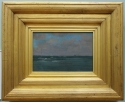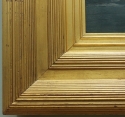The Paintings of James McNeill Whistler
YMSM 409
The Bathing Posts, Brittany

Date
The Bathing Posts, Brittany dates from the summer of 1893. 1

The Bathing Posts, Brittany, The Hunterian
In July 1893 Whistler and his wife were touring in Brittany and were not back in Paris until mid-September. On 17 August Whistler, writing from Perros Guirec on the north coast of Brittany, complained to his son, Charles Hanson, that it was too hot for painting: 'I came in the hope of being able to find a picture that might bring money - but the weather has been hopelessly staring bright & hot - So far it is all disappointment.' 2 According to the Pennells, the trip to Brittany in 1893 was 'not altogether a successful journey. Nature had gone back on him, he told me ... the weather was for tourists - the sea for gold-fish in a bowl - the studio was better than staring at a sea of tin.' 3
Despite this, he definitely did paint seascapes in Brittany including Violet and Blue: The Little Bathers, Perros-Guirec y382, Violet and Silver: A Deep Sea y411, Dark Blue and Silver y412, and Violet and Blue: Among the Rollers y413.
Images

The Bathing Posts, Brittany, The Hunterian

The Bathing Posts, Brittany, The Hunterian

The Bathing Posts, Brittany, frame detail

Peasant women standing under a tree, private collection

E. L. Boudin, Beach Scene, Trouville, 1863, National Gallery of Art, DC
Subject
Titles
Whistler's original title is not known. Variations on the title are as follows:
- 'Bathing Posts, Belle Isle' (1903/1915, Harold Wright). 4
- 'The Bathing Posts: Brittany' (1915, Colnaghi). 5
- 'The Bathing Posts, Brittany' (1980, YMSM). 6
Description

The Bathing Posts, Brittany, The Hunterian
A seascape in horizontal format. The viewpoint is very low, probably from the beach, and the horizon line is just below centre. The sea is a deep greenish blue, with waves visible along the horizon. Although the beach itself is not included, the sea changes colour to a lighter shade near the shore, and a series of small waves are breaking to left of centre. There are two bathing posts (slightly twisted narrow tree trunks), painted red and white, at left and right, marking the boundaries for safe bathing. A sailing boat in the middle distance at left, and a larger sailing ship – possibly a fishing boat – on the horizon to right, are framed by the posts.
Site
Probably Belle Ile in Brittany. The existence of bathing posts suggests that it was a popular beach, with a defined area for safe bathing, where boats were perhaps excluded, and, on the beach, bathing huts were allowed. However, except for the title, the activity on the beach is not indicated in Whistler's oil.

Peasant women standing under a tree, Private collection
Whistler's watercolour, Peasant women standing under a tree m1366, may originally have been called 'Breton Fisherwomen'. It includes two poles, and the foremost one was originally interpreted as a bare tree. However, the second bears a flag. It may actually represent Breton women on the beach waiting for the return of the fishing boats.

E. L. Boudin, Beach Scene, Trouville, National Gallery of Art, DC
There are tall posts on the shore in some paintings by Eugène Louis Boudin (1853-1898), such as Beach Scene, Trouville (1863, National Gallery of Art, Washington DC.), but they are more like flag-poles, and bear tricolour flags, and they are surrounded by fully dressed people standing and sitting on the beach. Some beaches had divisions by class, as well as activity, so Boudin's painting may represent a middle-class day-tripper area.
Comments
The Hunterian website commented:
'In the 1880s and 1890s Whistler worked 'en plein air' – in the open in front of his subject ... He worked on a small-scale, using easily portable panels. His colour range was narrow, but its tonal variety rich. The panels recall Corot's early paintings and the fluid sea pieces by his great French contemporary, Boudin.' 7
Technique
Technique

The Bathing Posts, Brittany, The Hunterian
The panel is a single section of mahogany-type wood. The wood grain runs horizontally across the long side of the panel. The brush-strokes of the pale, warm off-white, priming, as well as the wood grain, are visible through the thin paint. The priming provides a mid-colour for the blue-green paint. There may be a graphite pencil line defining the line of the horizon. Dr Joyce H. Townsend observed:
'The panel is well covered with paint, including wet-in-wet working of several tones of mushroom and lilac/mushroom for the clouds. The sea is economically painted with long horizontal strokes of slightly thinned paint, suggesting a slight swell. There are some more curling white brushstrokes for the foam on the waves … The sky and the sea are painted with distinct blues … likely Prussian blue.' 8
Conservation History
The panel has an auxiliary framing device, also in mahogany-type wood, made by adhering thin battens of the same materials, with mitred corners. 9
It was restored at some unknown date, and then cleaned and revarnished by John Bull in 1980. It is thinly painted and shows some signs of retouching to small damaged areas and thin paint. 10
Frame

The Bathing Posts, Brittany, The Hunterian

The Bathing Posts, Brittany, frame detail
It is in its original Grau style frame, dating from the 1890s. 11 40.4 x 48.0 x 5.6 cm.
History
Provenance
- 1903: in Whistler's studio at his death, and bequeathed to his ward and executrix Rosalind Birnie Philip (1873-1958);
- 1958: bequeathed by Miss R. Birnie Philip to the University of Glasgow.
Exhibitions
It was not exhibited in Whistler's lifetime, as far as is known, although the frame suggests it could have been exhibited in the 1890s. The first recorded exhibition was during First World War, when Miss Birnie Philip lent it to an exhibition at Colnaghi's in London. 12
Bibliography
Catalogues Raisonnés
- Young, Andrew McLaren, Margaret F. MacDonald, Robin Spencer, and Hamish Miles, The Paintings of James McNeill Whistler, New Haven and London, 1980 (cat. no. 409), plate 272, as 'The Bathing Posts, Brittany'.
Authored by Whistler
- None.
Catalogues 1855-1905
- None.
Journals 1855-1905
- None.
Monographs
- None.
Books on Whistler
- Berman, Avis, First Impressions: James McNeill Whistler, New York, 1993, repr.
- Enaud-Lechien, Isabelle, James Whistler, le peintre et le polémiste (1834-1903), Courbevoie, 1995, p. 151.
- Pennell, Elizabeth Robins, and Joseph Pennell, The Life of James McNeill Whistler, 2 vols, London and Philadelphia, 1908, vol. 2, p. 148,
- Spencer, Robin (ed.), Whistler: A Retrospective, New York, 1989, p. 333, pl. 106.
- Tanida, Hiroyuki, James M. Whistler, Tokyo, 1997, p. 94, repr. pl. 63.
Books, General
- Gaunt, William, Marine painting: an historical survey, London, 1975, p. 260.
- Wortley, Laura, British Impressionism. A Garden of Bright Images, London, 1988, p. 51, repr.
Catalogues 1906-Present
COLLEC|TION:
- Allan, Christopher J., A Guidebook to the Hunterian Art Gallery of the University of Glasgow, Glasgow, Hunterian Art Gallery, University of Glasgow, 1991, p. 15.
EXHIBITION:
- Loan Exhibition of Works by James McNeill Whistler to aid the Professional Classes War Relief Council, Messrs Colnaghi, London, 1915 (cat. no. 14) as 'The Bathing Posts: Brittany'.
- Young, A. McLaren, James McNeill Whistler, Arts Council Gallery, London, and Knoedler Galleries, New York, 1960 (cat. no. 56), repr. pl. 25.
- Spencer, Robin, James McNeill Whistler (1834-1903), Nationalgalerie, Berlin, 1969 (cat. no. 43).
- Pickvance, Ronald, James McNeill Whistler (1834-1903): An Exhibition of Works from the University of Glasgow Collection, Nottingham University Art Gallery, Nottingham, 1970 (cat. no. 88).
- Young, A. McLaren, Glasgow University's Pictures, Colnaghi, London, 1973 (cat. no. 71).
- Boyle, Richard, American Impressionism in the Pennsylvania Academy of Arts, Pennsylvania Academy of Arts,Philadelphia, 1976, p. 144.
- Bennett, Nicola, Landscape in Britain, 1850-1950, Arts Council of Great Britain, 1983, p. 71 (cat. no. 42).
- Sutton, Denys, and Martin Hopkinson, ホイスラー展. Whistler Exhibition in Japan, Tokyo, 1987 (cat. no. 27).
- Dorment, Richard, and Margaret F. MacDonald, James McNeill Whistler, Tate Gallery, London, Musée d’Orsay, Paris, and National Gallery of Art, Washington, DC, 1994-1995 (cat. no. 151).
Journals 1906-Present
- Lacambre, Genevieve, 'Whistler. L'exposition du Musee d'Orsay', Beaux Arts, 1995, repr.
Websites
- The Hunterian website at http://collections.gla.ac.uk/#/details/ecatalogue/41291.
- Art UK website at https://artuk.org.
Unpublished
- None.
Other
- Parkerson, Sarah Lawrence, Variations in Gold: The Stylistic Development of the Picture Frames used by James McNeill Whistlers, PhD thesis, University of Glasgow, 2007.
Notes:
1: YMSM 1980 [more] (cat. no. 409).
2: [17 August 1893], GUW #02005.
3: Pennell 1908 [more], vol. 2, p. 148.
4: Written by Harold Wright (1885-1961), art dealer at Colnaghi's, on a label on the verso, probably from information provided by the artist's sister-in-law, Rosalind Birnie Philip.
5: Loan Exhibition of Works by James McNeill Whistler to aid the Professional Classes War Relief Council, Messrs Colnaghi, London, 1915 (cat. no. 14).
6: YMSM 1980 [more] (cat. no. 409).
7: The Hunterian website at http://collections.gla.ac.uk.
8: Dr Joyce H. Townsend, Chief Conservator, Tate Britain, Report of examination, August 2017.
9: Townsend 2017, op. cit.
10: Condition report by Clare Meredith, 21 May 2001, Hunterian files.
11: Dr S. L. Parkerson Day, Report on frames, 2017; see also Parkerson 2007 [more].
12: Loan Exhibition of Works by James McNeill Whistler to aid the Professional Classes War Relief Council, Messrs Colnaghi, London, 1915 (cat. no. 14).